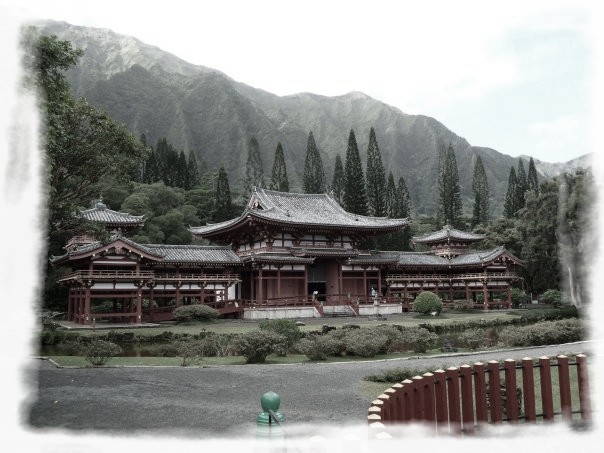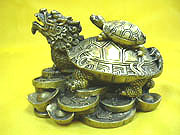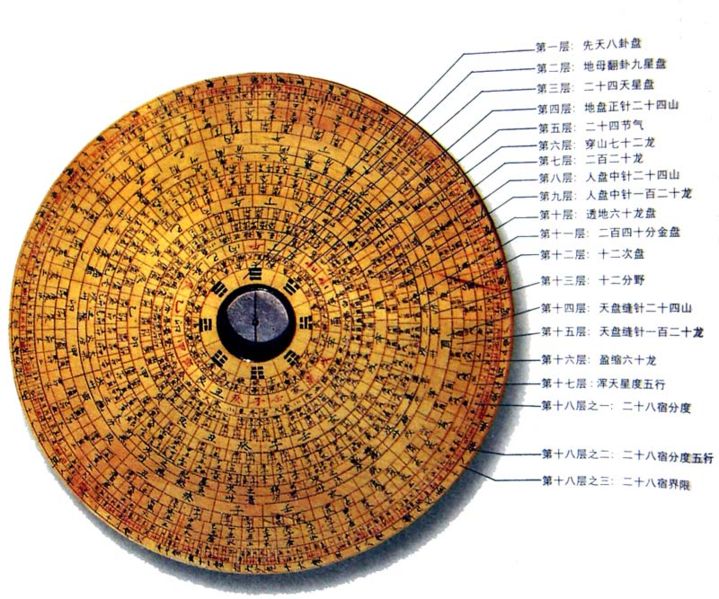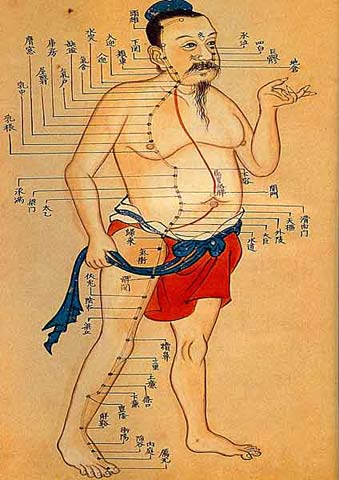About Feng Shui
![]() We offen hear the question: "What is Feng Shui?". The few that have heard of Feng Shui (pronounced fung shway) only think of its esoteric type that was very popular in the West in the 90ies, but little do they know what is actually behind the whole system of Feng Shui.
We offen hear the question: "What is Feng Shui?". The few that have heard of Feng Shui (pronounced fung shway) only think of its esoteric type that was very popular in the West in the 90ies, but little do they know what is actually behind the whole system of Feng Shui.
Feng Shui is a Chinese system of balancing our physical environment to promote harmony and a sense of well-being. Through very detailed observations of nature around us, the Chinese created various concepts to make use of what they learned. One is the system of Feng Shui.
It is applied from a home’s natural surroundings down to its furnishings and decor. It can start with finding a suitable property first and planning a whole estate down to modifying apartments and single rooms.
We believe that everything (and everyone) is affected by a life force we call energy, or "chi" (Chinese) / "ki" (Japanese). How we arrange objects, work with colours and materials will affect our lives and how we interact with our surroundings. Based on the three-fold idea that man (human kind) is in the center between heaven and earth (a concept called "San Cai"), we make our best efforts to harmonize both the heaven and earth energies and make the best use of their potentials for our life and us personally.
Feng Shui gives us the opportunity to work with the potentials of creating wealth and health and enhance our careers and relationships. We believe this is a great start... Why don't you start applying its methods today?
Feng Shui Techniques
Archaeological discoveries from Neolithic China and the literature of ancient China together give us an idea of the origins of feng shui techniques.
In premodern China, Yin feng shui (for tombs) had as much importance as Yang feng shui (for homes).
For both types one had to determine direction by observing the skies (also called the Ancestral Hall Method; later identified by Ding Juipu as Liqi pai, which in the West is often mistakenly labelled "compass school"), and to determine the Yin and Yang of the land (also called the Kiangxi method or Xingshi pai, which in the West has been labelled "form school").
Feng shui is typically associated with the following (most common) techniques:
Xingshi Pai (Form Methods)
- Luan Dou Pai (environmental analysis without using a compass)
- Xing Xiang Pai (Imaging forms)
- Xingfa Pai
Liqi Pai (Compass Methods)
San Yuan Method
- Dragon Gate Eight Formation
- Xuan Kong (time and space methods)
- Xuan Kong Fei Xing (Flying Stars methods of time and directions)
- Xuan Kong Da Gua ("Secret Decree" or 64 gua relationships)
San He Method (environmental analysis using a compass)
- Accessing Dragon Methods
- Ba Zhai (Eight Mansions)
- Water Methods
- Local Embrace
Others
- Four Pillars of Destiny (a form of hemerology)
- Eight Characters (the date and time of birth)
- Major & Minor Wandering Stars (Constellations)
- Five phases (relationship of the five phases or wuxing)
- BTB Black (Hat) Tantric Buddhist Sect (Westernised or Modern method not based on Classical teachings)
Feng Shui Methods
In premodern China, Yin feng shui (for tombs) had as much importance as Yang feng shui (for homes).
For both types one had to determine direction by observing the skies (also called the Ancestral Hall Method; later identified by Ding Juipu as Liqi pai, which in the West is often mistakenly labelled "compass school"), and to determine the Yin and Yang of the land (also called the Kiangxi method or Xingshi pai, which in the West has been labelled "form school").
Feng shui is typically associated with the following (most common) techniques:
 Xingshi Pai (Form Methods)
Xingshi Pai (Form Methods)- Luan Dou Pai (environmental analysis without using a compass)
- Xing Xiang Pai (Imaging forms)
- Xingfa Pai
 Liqi Pai (Compass Methods)
Liqi Pai (Compass Methods)San Yuan Method
- Dragon Gate Eight Formation
- Xuan Kong (time and space methods)
- Xuan Kong Fei Xing (Flying Stars methods of time and directions)
- Xuan Kong Da Gua ("Secret Decree" or 64 gua relationships)
 San He Method (environmental analysis using a compass)
San He Method (environmental analysis using a compass)- Accessing Dragon Methods
- Ba Zhai (Eight Mansions)
- Water Methods
- Local Embrace
Others
- Four Pillars of Destiny (a form of hemerology)
- Eight Characters (the date and time of birth)
- Major & Minor Wandering Stars (Constellations)
- Five phases (relationship of the five phases or wuxing)
- BTB Black (Hat) Tantric Buddhist Sect (Westernised or Modern method not based on Classical teachings)
History of Feng Shui
About Feng Shui
Feng Shui is a Chinese system of geomancy or simply "earth-wisdom" which uses the laws of both Heaven and Earth to help one improve life by receiving positive energy (qi | chi). The original designation for the discipline is Kan Yu.
Feng Shui, which literally means "wind" (Feng" and "water" (Shui), originates in China almost 6,000 years ago. It is an ancient method of constructing and optimizing residences and its surroundings to bring happiness, abundance and harmony into ones life. It includes architecture, urban planning, interior design, garden design, burial grounds and placement of objects in our environment. To harmonize the surrounding energy Feng Shui uses layout, framework, materials and colors of building and environmental structures. With this an ideal situation harmonizing the immediate environment can be created.
History of Feng Shui

The Lo Shu Turtle has been said to bring eight different types of heavenly blessings, and especially “wealth luck”. When it is depicted with a baby (right), it is said to be especially powerful. The image on the left is taken from Feng Shui Best Buy..
Already early in time, the people in China discovered the need of being protected from the influence of nature. Especially the climate, which in China has its axis from North to South was an important factor. Chinese buildings did not use glass windows or similar and where hence looking for ways to be protected from the cold winds. Through observation of nature, they found out, that the best place for a house is with a mountain range behind it, higher hills to the Eastern side, less high hills on the western side and an open view, ideally with some water like a river or lake, infront. This brought them the needed warmth from the sun light while being protected the cold northern winds. To explain these findings to illiterate people, the Chinese found a way of explaining a certain landscape by assigning it to the four animals (si ling). Today, the four animals are an integrated part of the Feng Shui Form school. The art of Feng Shui was refined over many centuries, producing an abundance of learned scholars.
Traditionally, Feng Shui was considered a highly guarded secret of the Chinese Imperial Court. All Feng Shui Masters were forbidden to release their potentially powerful knowledge to outsiders. Consequently, knowledge was handed down from father to son within family traditions. A few masters however ignored the laws and went out to help the poor who would not be able to afford the fee for a feng shui consultancy.
 Magic Squares and Turtles
Magic Squares and Turtles
Chinese literature dating from as early as 2800 BC tells the legend of The “Lo Shu Magic Square” or “scroll of the river Lo”.
More than 4.000 years go, Dayu (Great Yu), the founder of the Xia Dynasty (2100-1600 BCE) saw a turtle emerging from the Luo River and discovered the - what today is called - magic square on the turtles back. Today this pattern is still called "Luoshu" or alternatively "Guishu" (turtle pattern).
Dayu with his great knowledge on the universe, studied this pattern and gained a great understanding through it. Amongst others he developed a large system of waterways to prevent further flooding. The magic of the circle is its arrangements of dots, that when summed up always comes to: 15 (row, column and diagonally).
The number 15 equals the numer of days in each 24 cycle of the Chinese solar year. The legend of the Lo Shu Turtle is told in The Book of Rites, one of the five classical texts of ancient China.
Fu Xi - from Turtles to Trigrams
Fu Xi was the first of three noble emperors, the San-huang, in Chinese mythology. According to tradition he ruled from 2952 to 2836 B.C. (116 years). The Chinese attribute many inventions to the legendary emperor Fu Xi, like the use of fishing nets, the breeding of silk worms and the taming of wild animals. He apparently also invented music, however something he is most known for is the invention of the Eight Trigrams (Bagua) which is one of the tools used in Feng Shui, but also many other other ancient Chinese arts. Another important invention is the divination technique of casting oracles by the use of yarrow stalks.
Fu Xi is said to have invented the one hundred Chinese family names and decreed that marriages may only take place between persons bearing different family names.
“In the beginning there was the one.” [Lao Zi (Lao Tse) the father of Taoism
Coming back to the invention of the Eight Trigrams (Bagua) which represent the qualities of Heeaven, Earth, Thunder, Mountain, Water, Fire, Lake/Marsh and Wind. They symbolize the quality of change within the world. The trigrams are depicted in yin (broken) and yang (solid lines). They are hexagrams which means they consist of 6 lines. The change is indicated by only one different line between the trigrams. By knowing the essence of each change the user can not only find out more about him and his surroundings but can also predict what might happen next.
... China's oldest philosophical text: The I Ching
The I Ching (or Yi-Jing)
The Book of Change, or Yi Jing (known in the West as I Ching), is China's oldest philosophical text. Its origins are lost in the mists of time, but scholars believe the first compilation was done early in the Zhou Dynasty (1022 BC to 256 BC). The latest findings actually present a date right at the beginning of the Zhou dynasty. Based on a divination system using the eight trigrams (groups of solid and broken lines), permutations of 64 pairs of hexagrams were worked out. The story is that these hexagrams were already in existence before the invention of the Chinese writing system.
The hexagrams themselves are already full of symbolism and meaning, each trigram (one hexagram consists of 2 trigrams) has in itself already three meanings: one for heaven, one for earth and one for the human being.
In addition over time commentaries were added to the Yijing, it is important to point out that these are tools to help us understand the hexagrams but the main meaning is the hexagram itself.
"Lü / Treading [Conduct]
Above CH’IEN THE CREATIVE, HEAVEN
Below TUI THE JOYOUS, LAKETREADING.
Treading upon the tail of the tiger. It does not bite the man. Success.”
The Book of Change charts the movements and developments (hence, ‘change’) of all the phenomena in the universe. Many regard it as a complete system of philosophy in itself. Emperors, statesmen and generals throughout Chinese history consulted it. Revered by Confucius, the Book of Change was included in the five classic texts of Confucianism. It was one of the few books spared when Emperor Qin Shi Huang (259-210 B.C.) ordered the burning of previous dynasties’ works. The Illustrated Book of Changes is a venerable classic made available to modern readers in Chinese and English. The 64 hexagrams and their traditional commentaries are explained with illustrations, and the Chinese text has been written by leading calligraphers.
These five classic texts have spawned not only Feng Shui, but Tai Chi, Chi-Gong, Acupuncture, and other philosophies and sciences. The I Ching is one of the primary sources for the calculations of Feng Shui. If you look at a Chinese Luo Pan Compass, you will recognize the trigrams. The I Ching is always a tool for divination and is used in Chinese astrology.
For extensive background and detailed description of the I Ching, please see http://en.wikipedia.org/wiki/I_Ching
About 1,600 years ago, the Chinese had already determined that there were invisible forces at work beneath the earth.
The Chinese Compass (Luo Pan)
Already more than 1.600 years ago, the Chinese knew that there were invisible forces beneath the earth. These were later confirmed as magnetic forces. The Chinese divided these forces into positive (yang) and negative (yin) and developed a first compass for it. This compass traced the true magnectic forces. As a needle a spoon was placed in the middle.
Over time, this compass was further developed and the Luo Pan was born.
 The original magnetic compass used for navigation was constructed in the 7th or 8th century with the needle floating in water. The true North-South meridian was first set down by Chiu Yun Han (c. 713 - 741 A. D.) and known as the Cheng Chen.
The original magnetic compass used for navigation was constructed in the 7th or 8th century with the needle floating in water. The true North-South meridian was first set down by Chiu Yun Han (c. 713 - 741 A. D.) and known as the Cheng Chen.
This was used until roughly 880, when readings were so far off the mark that an immediate correction was required. In the eight or ninth century it was further refined with the discovery of magnetic declination. Yang Yun Sang added specialized compass points to compensate for the variation.
The Feng Chen or “seam needle” fixed the Cheng Chen’s variations.The compass was again adjusted in the 1100s when Lai Wen-Chun came up with the Chung Chen (the central needle). Chinese people used compasses for centuries prior to even the most rudimentary ones on European ships. As late as the seventeenth century, all Western compasses still pointed south just like the ancient south-pointing spoons they were built to imitate.
In Feng Shui, the luopan is an image of the cosmos (a world model) based on tortoise plastrons used in divination. At its most basic level it serves as a means to assign proper positions in time and space, like the Ming Tang (Hall of Light). The markings are similar to those on a liubo board.
The oldest precursors of the luopan are the shi (Chinese for astrolabe or diviner's board) also called liuren astrolabes unearthed from tombs that date between 278 BCE and 209 BCE. These astrolabes consist of a lacquered, two-sided board with astronomical sightlines. Along with divination for Da Liu Ren the boards were commonly used to chart the motion of Taiyi through the nine palaces. The markings are virtually unchanged from the shi to the first magnetic compasses.
During the Cultural Revolution (1966-1969), the old ways came under scrutiny and many ancient traditions were forbidden and destroyed. While traditional medicine received some official sanction from the government, Feng Shui did not. It was eventually outlawed. Ironically, since many Chinese leaders owed their rise to power to Feng Shui, they purposely kept Feng Shui texts hidden from the masses. Today, what little Feng Shui survives in China is under strict control of the Communist government. Some of the ancient Feng Shui knowledge has survived by people moving to Taiwan or Hong Kong. Feng Shui is still strong and used daily in both these territories.
Yin and Yang
The Chinese believe that there are energy forces (Chi) in the body as well as the universe. They believe that out of the one (wuji) comes Taiji (the potential) which gives birth to yin and yang. Out of yin and yang comes the bagua and out of the bagua comes the 10,000 things - basically everything we see and experience and much more. The Chinese also believe that these forces need to be balanced to bring harmony to life, nature and the universe. This principle is applied in all ancient chinese arts and wisdom traditions, like chinese medicine, taoism, tai chi and qigong, music and much more.
Feng Shui is the art of detecting the Chi in a room, building, or site, and regulating it for best results.
Feng Shui is the art of detecting the Chi in a room, building, or site, and regulating it for best results. The benefits of Feng Shui were once restricted only to the rich and powerful in China, but are now becoming widely available.
Simply put, Feng Shui harmonizes your surroundings with your own needs. It’s largely based common sense and it's not much to do with luck or superstition.
For example, it just feels better to have your back to a wall and see the door in your office. To have your back to the door, you tend to feel anxious that someone will sneak up on you. This makes you less productive. It is based on the human need of protection. In a working environment it also helps you to keep in touch with the bigger picture.
This is also why in a restaurant, everyone prefer to take the seat against the wall, looking out, with a view of the widest expanse of the room. They instinctually feel more able to protect their partners in this position. You are also safe from attack.
Feng Shui intuition runs very deep, and we all feel it. Knowing how to manipulate it is another matter. It is about taking care of a myriad of rules and details like this, in your home or office, which all add up. The overall effect can be improved dramatically by using these rules to adjust your furniture, objects, colors and materials. Once you find out about Feng Shui, you will never see the world the same way again.
Source: Feng Shui Harmony, Feng Shui Style (US), Wikipedia
Traditional Chinese Medicine - TCM
You are probably wondering why we have a fairly dominant link to Traditional Chinese Medicine (TCM) on our website, after all it is about Feng Shui... However, Feng Shui similar to TCM is about energy and both share a fair similar philosophies, ideas and systems. For example the flow in energy is as relevant to a room and its harmony as it is to a body and its health. Similarities for example can be found in the way energy flows through a room or flows through a body, as described and used in acupuncture.
With this in mind, here is a short summary on what Traditional Chinese Medicine is about:
TCM - Traditional Chinese Medicine
 What is Chinese medicine?
What is Chinese medicine?
Taoism is the indigenous belief system of China with a unbroken history of over 4.000 years. Taoists fulfilled roles similar to that of today's scientists, philosophers, doctors and priests today. A lot of the ancient Chinese thought has been influenced and developed by Taoism and for example found its way into medicine, feng shui and body practices like Qi Gong and Tai Chi.
Chinese medicine is at its core based on knowledge gained through meditiation and observation. Combining this with anatomical knowledge and philosophical concepts evolved into a comprehensive medical system today now known as Traditional Chinese Medicine (TCM).
TCM includes herbal medicine, dietetics, acupuncture, massage, qi gong and meditation all which has been refined through millennia of clinical usage.
The theory behind Chinese medicines is that a living human body is imbued with energy (qi) which is fundamental for its healthy functioning.
The ease with which this circulates directly correlates to your sense of being fully alive. Illness and disease are considered to arise or remain because this circulation is impeded in some way. Thus Chinese medicine aims to help release these blockages in the tissues, energy flow, and mind that can cause daily life to become a burden rather than a pleasure.
One way to view the channel system of acupuncture is to compare it with the way rivers, streams, reservoirs and underground springs function in nature, which then become a metaphor for the functions and transportation of the vital substances (qi [chi], blood, essence, body fluids) throughout the body.
Feng Shui places the same importance on unimpeded energy flows - only the focus is in the environment rather than in the body.
The goal of the Chinese Medical practitiioner and the feng shui consultant is to arrive at solutions to balance and harmonise a person’s “temples” i.e. their body and home; by adjusting the quality and quantity of Qi, yin/yang and the five elements to ensure a person is able to reach and maintain a complete state of full vigour and purpose enabling them to thrive in the areas of their lives that are important to them.
So what we can learn from Chinese Medicine and for example the field of acupuncture is a great enhancement to the understanding of energy flows analyzed and harmonized in Feng Shui.
In our section "The Basics" you will find more details on subjects like:
- Qi (Chi)
- Five Phases (5 Elements)
as well as other basic concepts helpful in understanding Feng Shui.
|
This article is based on the article Traditional Chinese Medicine from the free encyclopedia Wikipedia and it licensed under the double licence of GNU Free Documentation License und Creative Commons CC-BY-SA 3.0 Unported. On Wikipedia a list of authors for this article is available. This article has been adjusted and extended for the use on this website. |

